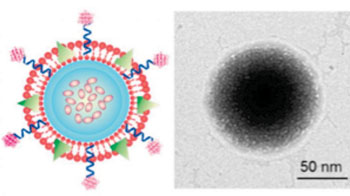Nanovesicles Coated with Platelet Membranes Target Cancer Cells and Reduce Doxorubicin Toxicity
By LabMedica International staff writers
Posted on 15 Oct 2015
A novel delivery system for the toxic chemotherapeutic drug doxorubicin (Dox) utilizes nanovesicles coated with extracted platelet membranes and the cytokine TRAIL.Posted on 15 Oct 2015
Although in use for more than 40 years as a primary chemotherapy drug, Dox is known to cause serious heart problems. To prevent these, doctors may limit the amount of Dox given to each patient so that the total amount a patient receives over her or his entire lifetime is 550 milligrams per square meter, or less. Furthermore, the necessity to stop treatment to protect the patient from heart disease may diminish the usefulness of Dox in treating cancer. TRAIL is a cytokine that is produced and secreted by most normal tissue cells. It causes apoptosis primarily in tumor cells by binding to certain death receptors. Since the mid-1990s it has been used as the basis for several anticancer drugs, but was not been found to have any significant survival benefit.

Image: On the left is the schematic design of the TRAIL/Dox loaded platelet membrane-coated nanogel delivery system. The TRAIL is attached on the surface of membrane and Dox is loaded in the core of nanogel. On the right is a transmission electron microscope image of the drug delivery system. Black is the synthetic core nanogel, the outside shell is the platelet membrane (Photo courtesy of Quanyin Hu, joint biomedical engineering program at North Carolina State University and the University of North Carolina).
Platelet membranes are a source of P-selectin proteins, which function as cell adhesion molecules (CAMs) on the surfaces of activated endothelial cells, which line the inner surface of blood vessels, and activated platelets.
Investigators at North Carolina State University (Raleigh, USA) and the University of North Carolina (Chapel Hill, USA) incorporated Dox into spherical nanovesicle gels that were subsequently coated with extracted platelet membranes and TRAIL.
The P-selectin proteins on the platelet membrane were expected to bind to CD44 proteins on the surface of cancer cells, locking the vesicles into place. TRAIL on the surface of the vesicles would attack the cancer cell membrane, and after ingestion of the nanovesicles by the cancer cells, the acidic environment inside the cells would break down the vesicles, freeing Dox to interfere with the cancer cells' nuclei. The platelet membrane-coated nanovesicles were able to survive in the circulation for up to 30 hours, as compared to approximately 6 hours for vehicles without the coating.
In a study using mice that was published in the September 29, 2015, online edition of the journal Advanced Materials, the investigators reported that the use of Dox and TRAIL in this drug delivery system was significantly more effective against large tumors and circulating tumor cells than using Dox and TRAIL in a nano-gel delivery system without the platelet membrane component.
"There are two key advantages to using platelet membranes to coat anticancer drugs," said senior author Dr. Zhen Gu assistant professor in the joint biomedical engineering program at North Carolina State University and the University of North Carolina. "First, the surface of cancer cells has an affinity for platelets - they stick to each other. Second, because the platelets come from the patient's own body, the drug carriers are not identified as foreign objects, so last longer in the bloodstream. We would like to do additional preclinical testing on this technique, and we think it could be used to deliver other drugs, such as those targeting cardiovascular disease, in which the platelet membrane could help us target relevant sites in the body."
Related Links:
North Carolina State University
University of North Carolina














